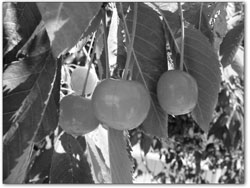|
|
||
|
Cherries in a jar by Chef Boy Ari I’m a fruit snob,” admits Tom McCamant, “I got into this business because I couldn’t find a good piece of fruit.” After spending a few minutes talking to this man, I’d have to agree that he is indeed a snob. And a nerd. That’s why I’m here. Tom knows things that will improve my ability to store fruit in jars. In his kitchen, Tom shows me how to use his refractometer, a device for measuring the soluble solids – mostly sugars – in fruit. The refractometer is one of the most important tools he uses at his orchard, Forbidden Fruit. Tom bites a cherry in half and squeezes a few drops into the gizmo. “A lot of people could grow better fruit if they had one of these,” he says, as he holds it to the window and squints into it. He goes on to explain that every fruit has an optimal sugar content at harvest time. If growers monitored their fruit’s sugar level, they could time their harvest for peak flavor. “We like our Bing Cherries to be around 25 percent,” says Tom. Each of their other cherry varieties, including Lambert, Sandra Rose, Regina, Rainier, Van, Skeena, Sonata, Attika, Early Robin, Black Gold and Sweetheart, has its own target sugar content. He also mentioned a cherry called Lapin, which I mistook for Lapping. I got quite a surprise while fact-checking this story when I did a Google search on “Lapping Cherries.” Whoa. Talk about forbidden fruit. Anyway, with cherry season upon us, Tom has two pieces of advice on how to obtain and preserve the best cherries. Stores often put their old cherries on top of the display, he says, hoping to sell them while they still can. But the difference between old and new cherries is as great as the difference between Lapin and Lapping. If you make a fuss, he claims, the produce person will pull out a box of the good stuff and let you select from it. His other nugget of wisdom is about canning your cherries (or any other fruit) in syrup. Like many things in Tom’s world, this brings us back to his refractometer. Assuming that your fruit was harvested at the proper time, with the proper sugar content, then you want to preserve it in a syrup of equal sugar content. Too much sugar in the syrup makes the cherries too sweet. Not enough sugar, and the imbalance pulls sugar out of the cherries and into the syrup. A syrup of equivalent sugar content will preserve the true flavor of the fruit. Jam, on the other hand, requires a lot of sugar, regardless of how sweet your fruit is. That’s because sugar is required to activate pectin, an important jam ingredient that gives the product its thick body. Pectin is a commercially processed powder that’s derived from the cell walls of certain fruits, like apples, plums and oranges. Available wherever canning jars are sold, pectin usually comes with instructions for how to make jam and jelly from just about any fruit. While these recipes call for a lot of sugar, the product will resemble what you had in mind when you decided to make jam. Using honey or other sugar substitutes is risky – odds are, the pectin won’t gel properly, and you will end up with something more liquid than solid.
There is, however, a brand of pectin called Pomona, which gels by interaction with calcium rather than sugar. The calcium comes in a little packet with the pectin, which you can find online at www.pomonapectin.com. Another way around the super-sweet jam problem is to use pie cherries for your jam. Pie cherries are so tart that even when you add sinful amounts of sugar to them, they don’t taste sickeningly sweet. The pectin will work properly, and your jam will thicken. And, your jam will rock. I would like to leave you with a jam recipe. But since jam is such a fickle, pectin-dependent product, and each brand of pectin is a little different, the most responsible thing I can tell you is to follow the recipes provided with your pectin. But since you read this far, I’ll give you a few tidbits of advice that they don’t mention in the pectin recipes. • Cherries are high on the Environmental Working Group’s list of foods most likely to be contaminated by agricultural chemicals. Often they are contaminated by more than one. It’s worth going organic! • Jamming is messy business. Dress in red or black, or nothing at all. • Buy a cherry pitter. You won’t regret it. • No matter what the recipe says, leave some of the cherries whole. • Many recipes call for lemon juice, so remember: fresh lemon juice beats the pants off the bottled stuff. Interestingly, lemon juice and zest contain pectin; it’s possible to make jam without commercial pectin by using pectin-containing fruits, like lemon (including zest) or even gooseberries. This is another good way to make low-sugar jam! A great way to serve your jam is in little cups with a lot of heavy cream. Happy lapping! •
|
In this week's issue...
- January 25, 2024
- Bagging it
State plastic bag ban is in full effect, but enforcement varies
- January 26, 2024
- Paper chase
The Sneer is back – and no we’re not talking about Billy Idol’s comeback tour.
- January 11, 2024
- High and dry
New state climate report projects continued warming, declining streamflows


